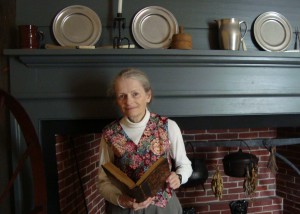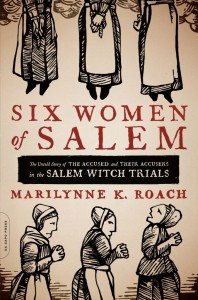
Marilynne K. Roach will lecture tomorrow at 6 p.m. at the New England Historic Genealogical Society (99-101 Newbury Street in Boston). Marilynne’s most recent book is Six Women of Salem: The Untold Story of the Accused and Their Accusers in the Salem Witch Trials, published by Da Capo Press.
Scott C. Steward: Your subjects are the accused and their accusers, and come from several economic and social strata. What makes them representative?
Marilynne K. Roach: The six women in my book, besides being specific individuals, can represent to some extent others of their varying stations in life: accused, accusers and both in one; free and slave; rich, poor, and middling; survivors and those who died. I also chose these six because enough information about their respective lives was available.
What might a book about six representative men look like?
A companion book on six representative men would not necessarily be confined to Salem’s geography, though their lives would certainly converge on the trials in that town. I believe I might choose:
Samuel Wardwell, a farmer and carpenter of Andover who made the mistake of openly telling fortunes, was accused (with his family), confessed, accused others, recanted, and was hanged;
Rev. George Burroughs, the not-quite orthodox former pastor of Salem Village, at odds with most of the Putnam family, involved in the frontier conflicts, seemingly possessed of an uncanny strength and foreknowledge of other people’s thoughts, was accused, found guilty, and hanged;
Rev. John Hale of Beverly, who was consulted at the beginning, believed the accusations of the afflicted, then doubted (his early doubts contradicted by the confessors’ own assertions), then realized just how wrong he was when his wife was accused;
John Hathorne, merchant and military leader in Salem, active in politics on the local and Province level, questioned the accused as a magistrate during preliminary hearings and presided as a judge of both the Court of Oyer and Terminer and the later Superior Court that tried the witch cases, condemning 30 of the suspects;
Thomas Putnam, a Salem Village farmer of a prominent family feeling edged out of its proper place, his eldest daughter one of the most afflicted girls, his wife beset by specters as well, actively produced a good part of the paperwork generated by the trials;
And for a sixth, perhaps Israel Porter, who disagreed with the course of the trials (and anything the Putnams supported).
It sounds like you should write that book!
The interview continues in Part Two.
 For more information on Marilynne Roach’s 12 March lecture, please visit: http://www.americanancestors.org/Event.aspx?id=29938.
For more information on Marilynne Roach’s 12 March lecture, please visit: http://www.americanancestors.org/Event.aspx?id=29938.
As one of the six men, how about my ancestor, Giles Corey? Basically, it appears he was guilty of being an extremely unpleasant person, as opposed to any creditable claims of witchcraft. His defiance of the court and the singular punishment he endured with stoic contempt make him a fascinating figure.
How about John Proctor ? Was hung on August, 19, 1692, for defending the girls. He was my my Tenth great grandfather.